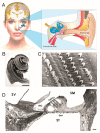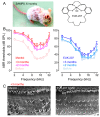Presbycusis: An Update on Cochlear Mechanisms and Therapies
- PMID: 31947524
- PMCID: PMC7019248
- DOI: 10.3390/jcm9010218
Presbycusis: An Update on Cochlear Mechanisms and Therapies
Abstract
Age-related hearing impairment (ARHI), also referred to as presbycusis, is the most common sensory impairment seen in the elderly. As our cochlea, the peripheral organ of hearing, ages, we tend to experience a decline in hearing and are at greater risk of cochlear sensory-neural cell degeneration and exacerbated age-related hearing impairments, e.g., gradual hearing loss, deterioration in speech comprehension (especially in noisy environments), difficulty in the localization sound sources, and ringing sensations in the ears. However, the aging process does not affect people uniformly; nor, in fact, does the aging process appear to be uniform even within an individual. Here, we outline recent research into chronological cochlear age in healthy people, and exacerbated hearing impairments during aging due to both extrinsic factors including noise and ototoxic medication, and intrinsic factors such as genetic predisposition, epigenetic factors, and aging. We review our current understanding of molecular pathways mediating ARHL and discuss recent discoveries in experimental hearing restoration and future prospects.
Keywords: age-related hearing loss; causal factors; mechanisms; presbycusis; therapies.
Conflict of interest statement
The authors declare no conflict of interest.
Figures





References
-
- Addressing the Rising Prevalence of Hearing Loss. World Health Organization; Geneva, Switzerland: 2018.
Publication types
Grants and funding
LinkOut - more resources
Full Text Sources
Medical
Research Materials

